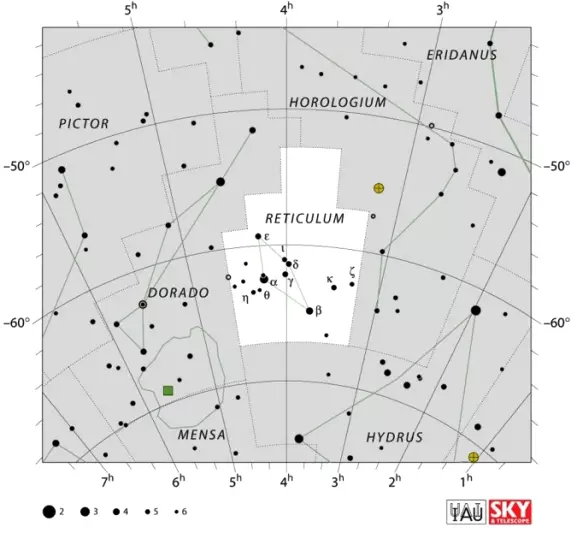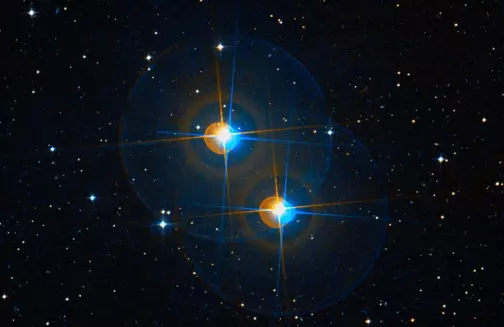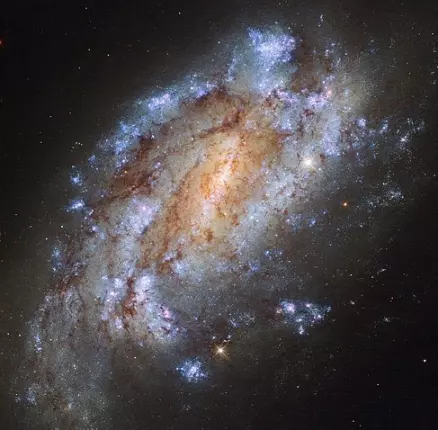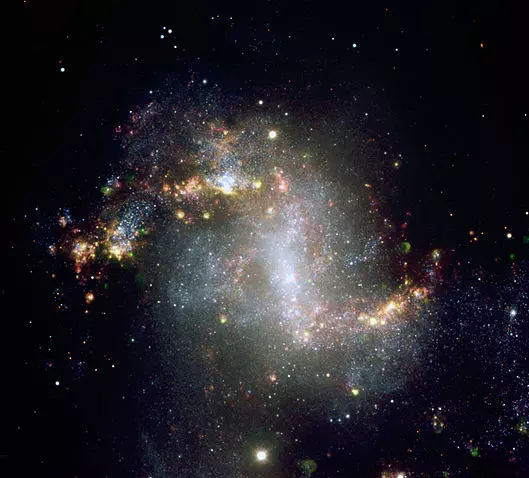Reticulum constellation lies in the southern sky. Its name means “the reticle” or “small net” in Latin.
Reticulum represents the small net at the focus of an eyepiece on the telescope which makes it possible to measure star positions. The constellation was introduced in 1621 by the German astronomer Isaac Habrecht II, who originally named it Rhombus. Nicolas Louis de Lacaille changed its name to Reticulum in the 18th century.
Reticulum contains two notable deep sky objects: the barred spiral galaxy NGC 1559 and NGC 1313, also known as the Topsy Turvy Galaxy.
Facts, location and map
Reticulum is one of the smallest constellations in the sky, 82nd in size, occupying an area of 114 square degrees. It is located in the first quadrant of the southern hemisphere (SQ1) and can be seen at latitudes between +23° and -90°. The neighboring constellations are Dorado, Horologium and Hydrus.
The constellation name Reticulum is pronounced /rɪˈtɪkjʊləm/. In English, the constellation is known as the Reticle. The genitive form of Reticulum, used in star names, is Reticuli (pronunciation: /rɪˈtɪkjʊlaɪ/). The three-letter abbreviation, adopted by the International Astronomical Union (IAU) in 1922, is Ret.
Reticulum belongs to the Lacaille family of constellations, along with Antlia, Caelum, Circinus, Fornax, Horologium, Mensa, Microscopium, Norma, Octans, Pictor, Sculptor, and Telescopium.
Reticulum contains five stars with confirmed planets and does not have any Messier objects. The brightest star in the constellation is Alpha Reticuli, with an apparent magnitude of 3.33. There are no meteor showers associated with the constellation.
The constellation Reticulum contains two named stars, Rhombus (Alpha Reticuli) and Tupi (HD 23079).

Reticulum constellation map by IAU and Sky&Telescope magazine
Story
Reticulum constellation was created by Isaac Habrecht II, who included it on his celestial globe in 1621. Habrecht named the constellation Rhombus.
In the 18th century, the French astronomer Nicolas Louis de Lacaille renamed it to le Réticule Rhomboide, or Reticulum, to commemorate the reticle in his telescope, which he used to measure star positions during his trip to the Cape of Good Hope in the early 1750s. The constellation was officially recognized by the International Astronomical Union in 1922.
Reticulum stars
Rhombus – α Reticuli (Alpha Reticuli)
Rhombus (Alpha Reticuli) is the brightest star in Reticulum. It has an apparent magnitude of 3.315 and lies 160 light-years away. It is a known X-ray source.
Alpha Reticuli is an evolved yellow giant or bright giant star. It has a mass of 3.12 solar masses and a radius 12.09 times that of the Sun. It is approximately 103 times more luminous than the Sun and has a surface temperature of 5,288 K. The star has an estimated age of about 330 million years old.
Alpha Reticuli has a 12th magnitude companion, CCDM J04144-6228B, at an angular separation of 48 arcseconds. The two stars may be physically related.
In 2024, the International Astronomical Union (IAU) approved the name Rhombus for Alpha Reticuli. Rhombus is the name of the obsolete constellation that later became Reticulum.
β Reticuli (Beta Reticuli)
Beta Reticuli is a triple star system about 100 light years away in Reticulum. It has an apparent magnitude of 3.84. The primary component in the system is an orange giant with the stellar classification K0IV SB.
ε Reticuli (Epsilon Reticuli)
Epsilon Reticuli is a double star in Reticulum. It consists of an orange subgiant and a white dwarf. The primary component has the stellar classification of K2 IV and an apparent magnitude of 4.44, and the companion belongs to the stellar class D and has a visual magnitude of 12.5.
The stars share a common proper motion through space and probably form a binary system. The system lies 59.5 light years from Earth.
A planet with a minimum mass of 1.17 times that of Jupiter was discovered orbiting the primary star in December 2000. The planet has an orbital period of 418 days, or 1.13 years.
γ Reticuli (Gamma Reticuli)
Gamma Reticuli is a red giant star belonging to the stellar class M4III. It has an apparent magnitude of 4.48 and is approximately 490 light years distant from the solar system.
δ Reticuli (Delta Reticuli)
Delta Reticuli is another red giant in Reticulum. It has the stellar classification of M2 III. The star has an apparent magnitude of 4.56 and is approximately 530 light years distant from the Sun.
κ Reticuli (Kappa Reticuli)
Kappa Reticuli is a binary star in Reticulum. It has an apparent magnitude of 4.71 and is about 70 light years distant from Earth.
The primary component is a yellow-white subgiant with the stellar classification of F5IV-V. It is believed to be about 1.8 billion years old.
ι Reticuli (Iota Reticuli)
Iota Reticuli is an orange giant with the stellar classification K4III. It has an apparent magnitude of 4.97 and is approximately 331 light years distant from the Sun.
ζ Reticuli (Zeta Reticuli)
Zeta Reticuli is a wide binary system composed of two yellow G-class stars, both of which have a visual magnitude of 5.22. The stars are gravitationally bound and located approximately 39 light years from the solar system. (Zeta-1 Reticuli is 39.16 light years distant and Zeta-2 Reticuli is 39.24 light years from Earth.) They are both solar analogs, which is to say they share similar characteristics with the Sun.
Zeta-1 Reticuli has the stellar classification of G3-5V, which means that it is a yellow main sequence star, and Zeta-2 Reticuli belongs to the stellar class G2V, and is also a yellow dwarf. The secondary component is known to be orbited by a circumstellar debris disk. The stars orbit each other with a period of over 170,000 years.
Both stars in the Zeta Reticuli system belong to the Zeta Herculis Moving Group of stars that share a common origin. The two stars are separated by 309.2 seconds of arc and appear as a close pair to the unaided eye in good viewing conditions.

Zeta Reticuli, image: Wikisky
η Reticuli (Eta Reticuli)
Eta Reticuli is a yellow giant star with an apparent magnitude of 5.24. It is approximately 380 light years distant from Earth. It has the stellar classification of G7III.
θ Reticuli (Theta Reticuli)
Theta Reticuli is a double star with an apparent magnitude of 5.88. The primary component is a blue-white star halfway between the subgiant and giant stage of evolution. The star is approximately 462 light years distant from the Sun.
R Reticuli (S Reticuli)
R Reticuli is a Mira variable, a strikingly red pulsating variable star that will expel its outer envelope as a planetary nebula within a few million years and become a white dwarf.
It has an apparent magnitude of 9.23 and is approximately 5,000 light years distant from the Sun.
Tupi – HD 23079
HD 23079 is a main sequence star of the spectral type F9.5V. It lies 109.2 light-years away and shines at magnitude 7.12, below unaided eye visibility.
The star is similar in mass and radius to the Sun. It has a mass of 1.01 solar masses and a radius of 1.08 solar radii. With an effective temperature of 6,003 K, it shines with 1.372 solar luminosities. It has an estimated age of 5.1 billion years.
A giant planet was discovered orbiting the star in October 2001. The planet, HD 23079 b, has a mass at least 2.41 times that of Jupiter and orbits the star with a period of 724.5 days at a distance of 1.586 astronomical units (AU).
HD 23079 was named Tupi, after the indigenous people of Brazil, and the planet was named Guarani, after a group of indigenous peoples of South America, during the International Astronomical Union’s IAU100 NameExoWorlds campaign.
HD 25171
HD 25171 is a yellow-white main sequence star with an apparent magnitude of 7.79. It can be seen in a small telescope. The star is approximately 179 light years distant from the solar system.
HD 25171 has the stellar classification F8 V and is slightly larger and more massive than the Sun. It has 189 percent of the Sun’s luminosity and is about four billion years old, roughly the same age as the Sun.
The star has a planet with a mass 0.95 times that of Jupiter orbiting it with a period of 1,845 days.
HD 23127
HD 23127 is a yellow dwarf with the stellar classification G2V. It has an apparent magnitude of 8.58 and is approximately 320 light years distant from Earth. The star has 1.13 times the Sun’s mass and twice the Sun’s metal content. It is believed to be around seven billion years old.
A planet at least 37 percent more massive than Jupiter was discovered orbiting the star on February 9, 2007. The planet has an orbital period of 1,214 days.
HD 27894
HD 27894 is an orange dwarf star belonging to the stellar class K2 V. It has an apparent magnitude of 9.42 and is approximately 143 light years distant. A planet was discovered in the star’s orbit in 2005. The planet has a mass 0.62 times that of Jupiter and it orbits the star with a period of 17.991 days.
Deep sky objects in Reticulum
NGC 1559
NGC 1559 is a barred spiral galaxy classified as a Seyfert galaxy. It has an apparent magnitude of 11 and is approximately 50 million light years distant.
The galaxy is about seven times smaller than the Milky Way. It has massive spiral arms and contains regions of intense star formation. The galaxy’s disc and bar are a source of strong radio emissions.
Three supernovae were observed in the galaxy in recent decades, SN 1984J in 1984, SN 1986L in 1986 and SN 2005df in 2005.

NGC 1559, image: ESA/Hubble & NASA
Topsy Turvy Galaxy – NGC 1313
The Topsy Turvy Galaxy, NGC 1313, is another barred spiral galaxy in Reticulum, which is also a starburst galaxy. It is approximately 15 million light years distant from the Milky Way and spans about 50,000 light years.
The galaxy is notable because it is very uneven in shape and its axis of rotation is not located in its centre. This would usually be a result of a collision with another galaxy, but NGC 1313 appears to be alone.
The galaxy was discovered by the Scottish astronomer James Dunlop on September 27, 1826. It is located near the galaxy NGC 1309 in Eridanus constellation, where a supernova was discovered in 1987.

The central parts of the starburst galaxy NGC 1313. The very active state of this galaxy is very evident from the image, showing many star formation regions. A great number of supershell nebulae, that is, cocoon of gas inflated and etched by successive bursts of star formation, are visible. The green nebulosities are region emitting in the ionised oxygen lines and may harbour clusters with very hot stars. This colour-composite is based on images obtained with the FORS1 instrument on one of the 8.2-m Unit Telescope of ESO’s Very Large Telescope, located at Cerro Paranal. The data were obtained in the night of 16 December 2003, through different broad- (R, B, and z) and narrow-band filters (H-alpha, OI, and OIII). The data were extracted from the ESO Science Archive and fully processed by Henri Boffin (ESO). Image: ESO